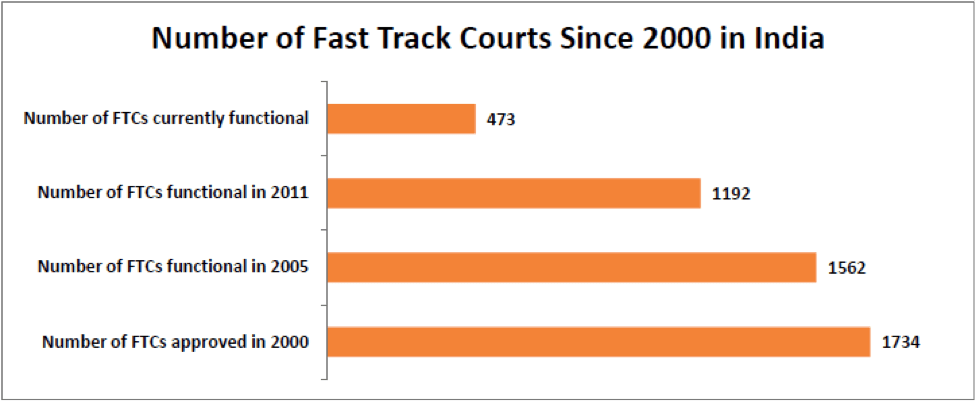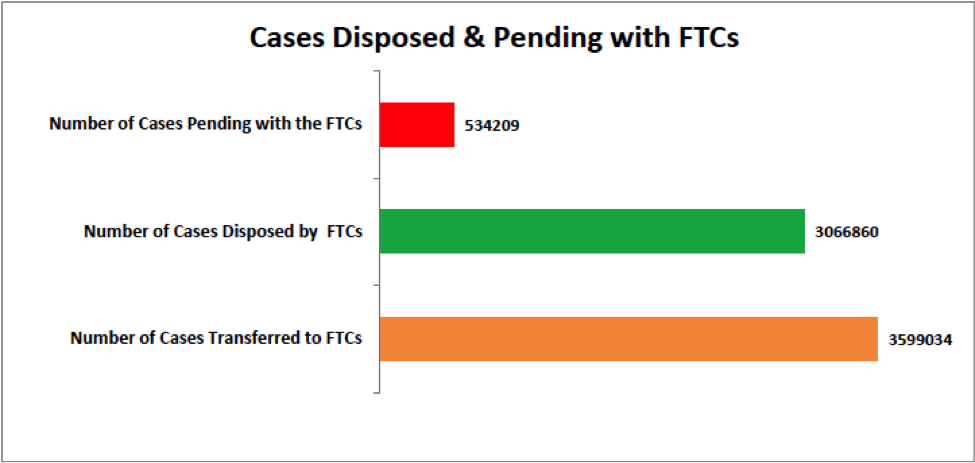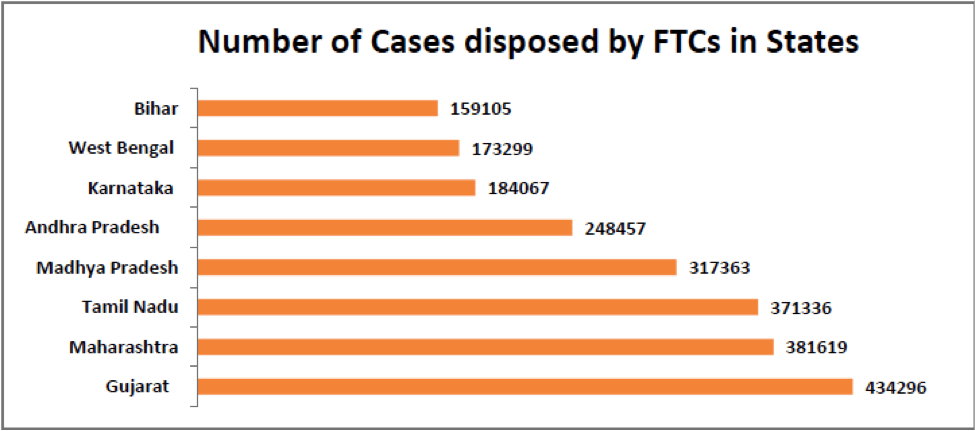[orc]Huge Pendency in courts is a major bottleneck in providing timely justice to victims. More than 3 crore cases are pending across all the courts in the country. More than 2/3rd of these cases are pending in the lower judiciary. Establishment of Fast Track Courts in the year 2000 was a step in the right direction. But data indicates that most states have discontinued the FTCs once the central government stopped funding in 2011.
According to estimates, more than 3 crore cases are pending across all the courts in the country. Close to 2/3rd of these cases are more than 3 years old and more than 2/3rd of these cases are pending in the district & sub-ordinate courts. ‘Justice Delayed is Justice Denied’ is used whenever there is an undue delay in disposal of cases. As Factly reported earlier, our prisons are also overcrowded, thanks to the slow pace of our judiciary. But data suggests that Fast Track Courts (FTCs) might help in bringing down pendency, provided the governments are interested.
Establishment of Fast Track Courts (FTCs)
The Eleventh Finance Commission recommended the creation of 1734 Fast Track Courts (FTCs) in the country for disposal of long pending cases in Sessions courts and other courts. The FTCs were established to expeditiously dispose of long pending cases in the Sessions Courts and long pending cases of under trial prisoners. The term of the Fast Track Courts which were recommended by the Eleventh Finance Commission ended on 31st March, 2005. Based on the directives of the Supreme Court of India, the Government accorded its approval for the continuation of 1562 FTCs that were operational as on 31st March, 2005 for a further period of 5 years i.e. up to 31st March, 2010 with a provision of Rs. 509 crores. The scheme was further extended for a period of one year i.e. up to 31st March, 2011. It was then decided that there would be no central funding to FTCs beyond 2011.
Fast Track Courts were meant to expeditiously clear the large scale of pendency in the district and subordinate Courts under a time-bound programme. A laudable objective of the five year experimental scheme was to take up on top priority, the cases involving under trials. Under the government’s action plan, the fast track courts would take up as their next priority, cases pending for two years or more, particularly in which the accused persons had been on bail.
Appointment of Judges
The idea was to establish an average of five FTCs in each district, with priority accorded to those states & districts with large pendency. The scheme envisaged the appointment of ad hoc judges from among retired sessions judges, judges promoted on ad hoc basis etc. Selection of judges was to be done by the High Courts. As per the plan, the fast track courts were required to dispose of 14 trial cases and/or 20 to 25 criminal/civil cases every month.
Number of FTCs
A total of 1734 FTCs were approved in 2000 following the report of the 11th Finance Commission. Out of this, only 1562 were functional by 2005, the year when this experimental scheme was supposed to end. The central government in 2005, decided to continue its support for the 1562 functional FTCs for the next 6 years (till 2011). By the end of 2011, only 1192 FTCs were functional. This is also the year when the central government stopped financial support to the FTCs. The states were supposed to continue FTCs with expenses met from their own funds. As expected, not many states were interested and more than 60% of these FTCs were closed down. As per the latest available data , only 473 FTCs are functional in the country.
Within states, Uttar Pradesh was approved the maximum number (242) of FTCs in the year 2000. This number came down to 153 in 2011 and is currently at 80. Maharashtra also had just 51 FTCs in 2011 compared to the approved number of 187 in 2000. But the number has since increased to 80. In Andhra Pradesh, West Bengal & Gujarat, more than 50% of the FTCs functional in 2011 are still functioning. In the other bigger states of Bihar, Karnataka, Madhya Pradesh & Rajasthan, not a single FTC is functioning as on date.
| State | Number of FTCs approved in 2000 | Number of FTCs functional in 2005 | Number of FTCs functional in 2011 | Number of FTCs currently functional |
|---|---|---|---|---|
| Uttar Pradesh | 242 | 242 | 153 | 80 |
| Maharashtra | 187 | 187 | 51 | 80 |
| Andhra Pradesh | 86 | 86 | 108 | 72 |
| West Bengal | 152 | 119 | 109 | 64 |
| Gujarat | 166 | 166 | 61 | 61 |
| Bihar | 183 | 150 | 179 | 0 |
| Karnataka | 93 | 93 | 87 | 0 |
| Madhya Pradesh | 85 | 66 | 84 | 0 |
| Rajasthan | 83 | 83 | 83 | 0 |
Performance of these FTCs
Since inception, close to 36 lakh cases were transferred to the FTCs out of which, close to 30.7 lakh have been disposed. About 5.3 lakh cases are still pending with FTCs. FTCs have disposed more than 80% the cases transferred to them.
More than a lakh cases were disposed by the FTCs in 11 states. In eight of these 11 states, more than 1.5 lakh cases were disposed. Most number of cases were disposed by FTCs in Gujarat (4.3 lakh), followed by Maharashtra (3.8 lakh), Tamil Nadu (3.7 lakh) and Madhya Pradesh (3.2 lakh). Strangely, the data indicates that not a single case has been transferred to the FTCs in Uttar Pradesh since inception. The year wise disposal details are not available to be able to make an analysis of the efficiency of the FTCs.
Is it expensive to setup & run the FTCs?
The total amount of central grants released to states for FTCs since inception is more than 870 crore rupees. This is an average of 80 crore per year. Even if the states have to match this amount and bear the entire expenditure by themselves post 2011, the fund requirement is less than 0.01% of the budget of most states. Hence funds are not at all an issue if the state governments were interested.
In its judgment in the Brij Mohan Lal case, the Supreme Court has endorsed the position of the Central Government and held that the continuation of FTCs is within the domain of the States with their own funds. As noted earlier, some states have continued support for FTCs while others did not.
What is the Current Status?
In the Conference of Chief Ministers and Chief Justices held in April 2013, it was resolved that the State Governments, in consultation with the Chief Justices of the respective High Courts, take necessary steps to establish suitable number of FTCs to expedite cases relating to offences against women, children, differently abled persons, senior citizens and marginalized sections of the society, and provide adequate funds for the purpose of creating and continuing them.
The 14th Finance Commission has also endorsed the proposal of establishing 1800 FTCs for a period of five years for cases of heinous crimes; cases involving senior citizens, women, children, disabled and litigants affected with HIV AIDS and other terminal ailments and civil disputes involving land acquisition and property/rent disputes pending for more than five years at a cost of Rs.4144 crore. The 14th Finance Commission has suggested that, half of the grants-in-aid to the States/UTs be utilized for setting up of the FTCs.
States have to properly utilize the amount earmarked by the 14th Finance Commission for the establishment of FTCs if pendency in lower judiciary has to come down substantially. Until then, Justice will be delayed.
Feature Image Source: Gpics at English Wikipedia [GFDL, CC-BY-SA-3.0 or CC BY-SA 2.5-2.0-1.0], via Wikimedia Commons






1 Comment
Pingback: ‘See You In Court’ Or ‘See You Out Of Court’? A Burdened Judicial System - Can ADR System Be An Answer? (Part I) | Live Law